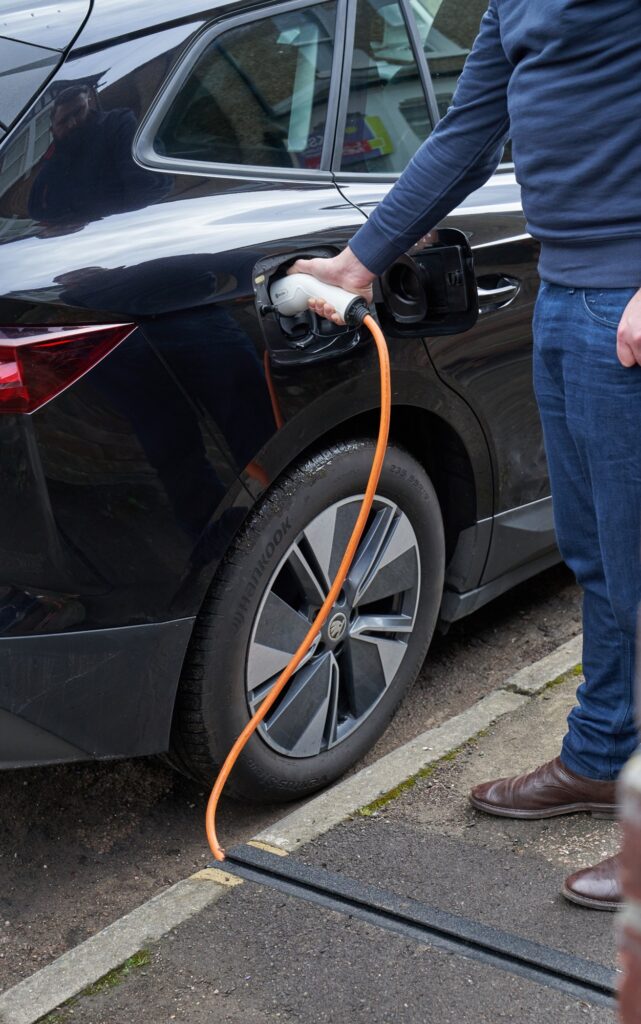

Around 25% (6.6 million[1]) of UK households rely on on-street parking and are therefore unable to charge EVs at home.
Reliance on charging away from home represents a substantial barrier to EV adoption. Aside from logistical impracticalities, public and destination charging (such as on-street, public/private car parks, and service stations) is more expensive.
The need for home charging options is evidenced by a rise in the number of EV users trailing charging cables across public highways, generating trip hazards and diminishing inclusive mobility.

The Gul-e product is an elegantly simple and discrete solution: it is an EV charging cable gully channel, with solid chequerboard plates, and brushes to protect the recess from dirt and debris.
It is seamlessly and permanently encased in the footway which safely houses a charging cable.
To charge their EV, the user simply parks on the street in front of their home, feeds the charging cable into the Gul-e and plugs their vehicle into their own home charger.
Protected by the chequer plate panels and brushes, the charging cable passes unimpeded and unnoticed across the pavement.
Its main key benefits are:
The Gul-e by ODS project began life in Oxford. It was initially funded by the Office for Zero Emission Vehicles (OZEV) and Innovate UK under the competition: Infrastructure Solutions for Zero Emission Vehicles. Oxfordshire County Council (OCC), ODS and Oxford City Council formed the project group.
The project started in Oxfordshire in 2021 with the installation of 26 units at separate properties who partook in a trial. Since then, the solution has started to open up to other parts of the UK where they seek to support and provide guidance, through their own experiences, to Local Authorities who would like to trial the Gul-e solution in their respective areas.
As such, Central Bedfordshire started a trial of 20 units in October 2022, a trial also commenced in the London Borough of Bromley, Buckinghamshire County Council and Solihull Council in 2023. Trials in Surrey County Council and Gwent Council will be underway soon.
Due to the regulatory landscape, there are different considerations for Local Authorities depending on the ownership model employed.
There currently seems to be three broad, potential ownership models:
The Highway Authority commissions the installation of the Gul-e or adopts the Gul-e after installation. The Highway Authority is responsible for enforcing safe and proper use, and providing maintenance of the Gul-e. The Highway Authority may licence or otherwise permit the use of a Gul-e, and may recoup costs from the user for licensing, installation (if appropriate) and maintenance.
The end user commissions the installation of the Gul-e and is responsible for obtaining appropriate licenses from the council to own and operate equipment in the highway. The Highway Authority may licence the installation and operation of a Gul-e and, may recoup costs from the user.
The end user requests the installation of the Gul-e from a third party. The third party is responsible for obtaining appropriate licenses from the council to own and operate equipment in the highway. The Highway Authority may licence the installation and operation of a Gul-e and may recoup costs from the third party. The Highway Authority is responsible for enforcing safe and proper use, and monitoring and taking enforcement action where Gul-e is not correctly maintained and in safe condition.
Each Local Authority that is responsible for Highways may have different requirements, constraints and obligations which could alter the ownership model responsibilities.
As part of its commitment towards net zero emissions by 2050, the UK Government set out its Ten Point Plan for a Green Industrial Revolution in 2020. This Ten Point Plan focused on accelerating the transition to EVs and supporting their adoption.
To enable sufficient uptake, charging must be accessible and affordable for all. Last year, the Government launched the £381m Local EV Infrastructure Fund (LEVI) and updated its On-Street Residential Chargepoint Scheme (ORCS) – both designed to support Local Authorities in accelerating the delivery of charging infrastructure to residents without off-street parking.
This fund built on the success of the long-term ORCS scheme, which has delivered 14,000 public chargepoints since its inception, and a pilot LEVI scheme that delivered almost 3,400 chargepoints and 1,000 gullies.
The Government’s Plan for Drivers, published in the autumn of last year, also committed to widening the eligibility of these local infrastructure funds to include cross-pavement solutions. More guidance and explainer links can be found on the OZEV website.
To further support EV drivers who don’t have access to off-street parking, the government launched the Electric Vehicle Chargepoint Grant in March 2024. This grant will finance 75% of the cost of buying and installing a home chargepoint, up to a maximum of £350, and is open to EV drivers who have obtained permission from their council to install a cross-pavement solution such as Gul-e.
All the details and applications can be found online.

In addition to the Local Authorities mentioned above, Gul-e is currently working with several Local Authorities (Central Bedfordshire, Cherwell and Solihull) and they are eager to support even more Local Authorities who would like to conduct a trial in their area.
If you would like to register your interest, you can contact Gul-e who will reach out to your Local Authority on your behalf and enquire about trial installations. The more interest they receive, the easier it is to potentially make Gul-e available where you live.
Alternatively, there are also options for Gul-es to be supplied for installation on private land, which can be a faster process due to approval from Local Authorities not being required.
To discuss further or to find out more, please contact gul-e@odsgroup.co.uk.
[1] Field Dynamics (2020): https://www.field-dynamics.co.uk/25-drivers-no-off-street-parking/